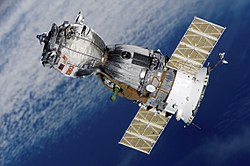 | |
| Manufacturer | OKB-1 |
|---|---|
| Country of origin | Soviet Union |
| Operator | Soviet space program |
| Applications | Crewed spacecraft to dock with space station |
| Specifications | |
| Dimensions |
|
| Regime | Low Earth orbit |
| Design life | Up to 35 days |
| Production | |
| Status | No longer in service |
| Launched | 2 |
| Maiden launch | Soyuz 10 22 April 1971 |
| Last launch | Soyuz 11 6 June 1971 |
| Related spacecraft | |
| Derived from | Soyuz 7K-OK |
| Derivatives | Soyuz 7K-T |
Soyuz 7K-OKS (also known as Soyuz 7KT-OK) [1] is a version of the Soyuz spacecraft and was the first spacecraft designed for space station flights. Its only crewed flights were conducted in 1971, with Soyuz 10 and Soyuz 11.
